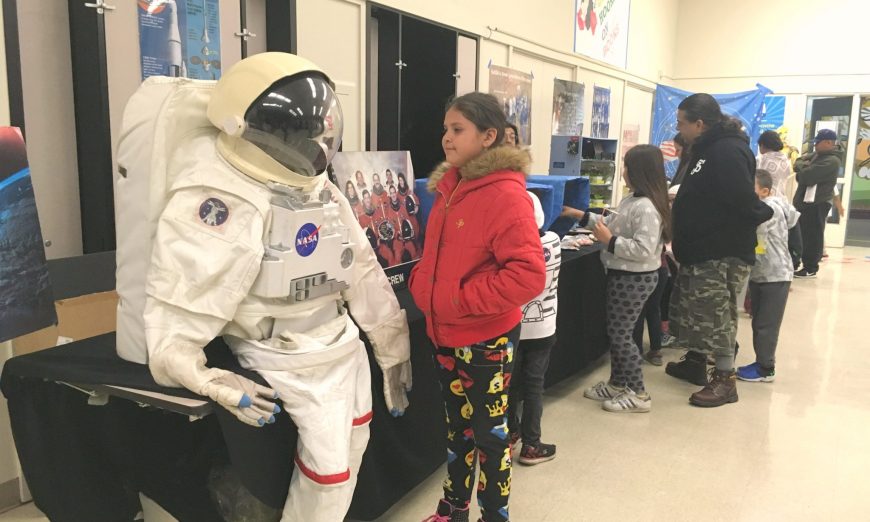At Bracher Elementary School’s Jan. 26 STEM Night, students experienced the hands-on side of science, technology, engineering and math. They touched Jungle James’s 11 ft. Burmese python, Slim Jim. They punched buttons on remote controls to race Lego trains and scored tickets to spin a prize wheel for science kits. They threw paper airplanes into a wind turbine, created by Ryan Hoagland, a former parent at the school. They also learned about outer space from associates of NASA (National Aeronautics and Space Administration).
“Tonight, I petted the back of an 11 ft. snake for the first time in my life,” said Wayne Leach, Principal of Bracher Elementary School. “I love watching the excitement of the kids. This is our third year doing a STEM Night. This is the first year we’ve added Jungle James and NASA.”
“We want kids who attend this Title 1 school to see that science can be a part of everyday life,” said Maria Cecilia Altamirano, a Bracher Elementary School parent volunteer. “A big chunk of our school population lacks exposure to the sciences that other kids take for granted. We hope this exposure can inspire the kids to get a Bachelor’s degree in the sciences or in any of the STEM fields.”
At the NASA table, a faux spacesuit was propped up so that children could compare their height to the height of the suit.
“The spacesuit was brought to classrooms to show kids how the suit can be used in space to give them a feel for how hard it is for humans to be in space,” said Andy Wissink, an aerospace engineer who is employed by the U.S. Army and works at NASA. “The suit that was here was not a real astronaut spacesuit, although it was designed by the people who designed the real spacesuit. Real astronaut spacesuits are very expensive. A real spacesuit has a panel that controls things, such as oxygen and the air pressure inside the suit. It’s a vacuum in space so astronauts need to have the air pressure that we feel here on earth and that’s why the spacesuit is pressurized.”
A parent volunteer at the event, Wissink also brought his son’s robot toys and pointed out to children that NASA is moving toward the use of more robotics for space exploration.
On the NASA table were dried bananas and apples, food for astronauts. Separate from the food was a growth chamber, which looked like a small bookcase filled with plants.
“The name of this project is called CELSS (Controlled Ecological Life Support System) and it is a growth chamber that NASA is developing,” said Dora Herrera, an electronic technician at NASA. “In order for astronauts to do well in outer space, they have to have good nutritious food. A project like this would have a growth chamber for the control and two chambers for the plants to grow in. The plants get vitamins and minerals from the water that are circulated to the roots. The water filters down to the bottom where they have the filter. [It] cleans the water and recycles it over and over again.”






